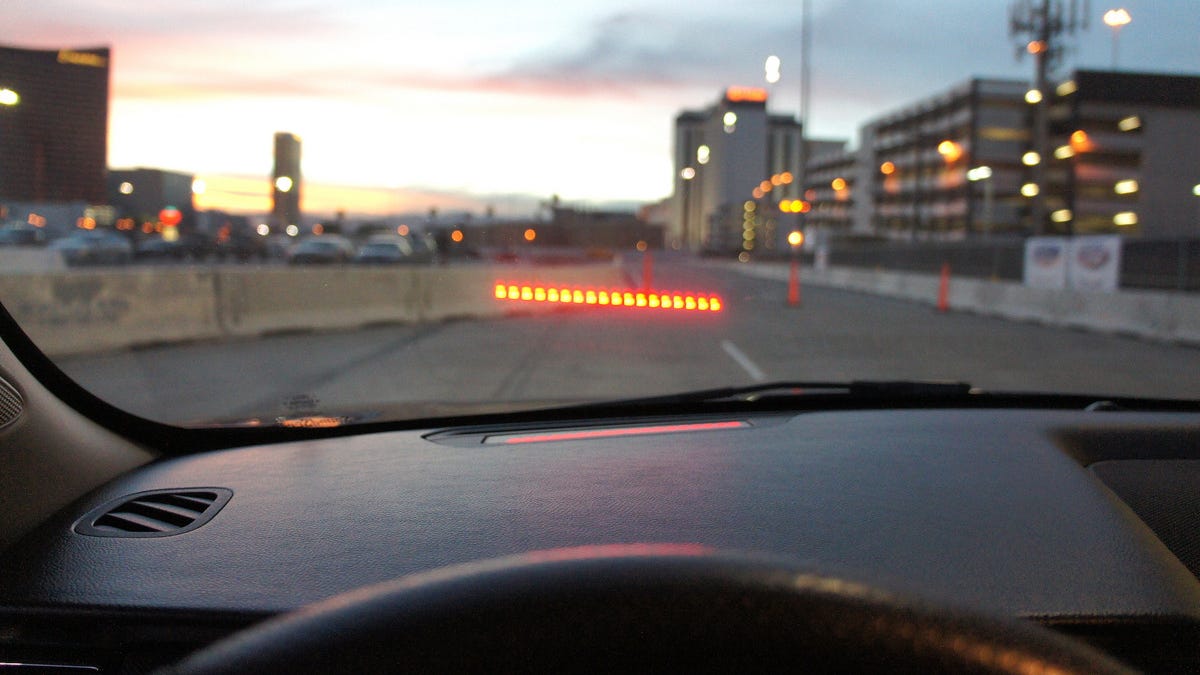Ford highlights V2V safety tech with daredevil drivers
At the Driverless Car demonstration area on the CES 2014 grounds, Ford is showing how vehicle-to-vehicle communication can save lives.

LAS VEGAS -- I'm sitting in the passenger seat of a Ford Taurus as the driver accelerates toward a green light. Suddenly, a red warning light flashes on the windshield and an alert tone sounds off. The driver hits the brakes, and another car goes flying by, across our path at the intersection.
While this was a demonstration at a fake intersection, with Ford drivers piloting each car, we were traveling at speed and there was certainly the potential for a crash. It was a recreation of a real-world situation that happens everyday at intersections.
However, the reason why the Taurus was able to alert the driver with light and sound, came down to a vehicle-to-vehicle communication system (V2V) installed in each car.
The V2V system includes GPS and a Dedicated Short Range Communication (DSRC) transceiver operating over the 802.11p standard. Each car was sending its GPS location out, including current path and speed, while receiving broadcasts from other cars in the vicinity.
The Taurus received the telemetry data from the car crossing our path, quickly calculated the potential for a collision, and alerted the driver to hit the brakes. Systems such as this are likely to be implemented in all cars, possibly by federal mandate, in the near future and will prevent collisions and fatalities.
A multitude of automakers ran a National Highway Traffic Safety Administration-sponsored test around Detroit, using V2V to see how the cars communicated with each other, and how drivers responded to alerts. This type of V2V system only works when a majority of cars implement the technology.
Ford ran me through a few other demonstrations of the technology. In one, the Taurus followed closely behind another car. The lead car suddenly changed lanes to avoid a stalled car immediately ahead. In a real world situation, the driver of the Taurus would either have to panic stop or may hit the stalled car. However, the V2V system flashed its red light and sounded its warning tone before the car ahead switched lanes, because the stalled car sent a signal out that it was stopped.
In another demonstration, V2V worked as a blind spot detection system. As the Taurus drove a straight line, another car came up on the right. Instead of using a sensor, as in current blind spot monitor systems, the Taurus received the signal from the other car that it was approaching from behind. The system activated the blind spot warning light in the side view mirror.
In these demonstrations, the system worked remarkably well, and did not have to rely on radar or any other kind of external sensor.
The V2V system in the Taurus involved fairly mild modification to the production vehicle. Ford added a shark fin antenna, combining both GPS and the DSRC signal to the roof. The signals were processed in the car's computer, which decided when it was necessary to flash the warning light.
Because of the simplicity of the system, it could also be a relatively cheap aftermarket addition to existing cars.
The DSRC signal has a range of about 1,500 feet, far enough to give a car alerts about others which are not currently visible. The processor in the car saves a breadcrumb GPS trail from other cars covering about 1,000 feet of travel, enough to compute whether a collision is imminent.

